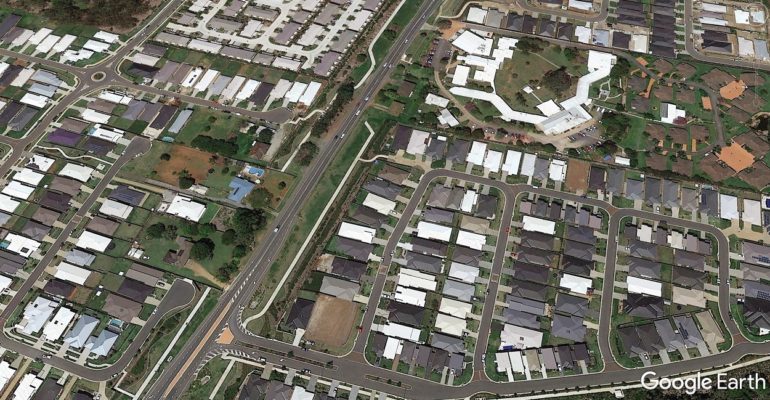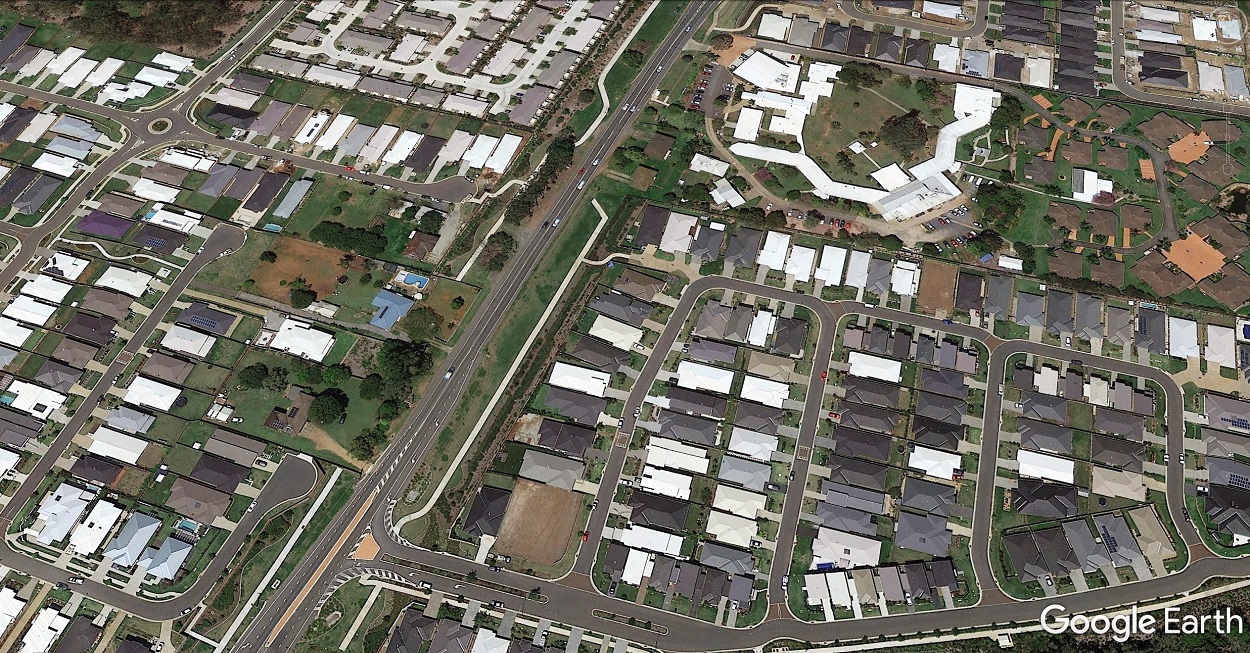

Small lot residential development in Redland City has been an outcome of Queensland’s planning laws
South East Queensland residents want State Parliament to improve planning laws which currently favour developers’ interests over residents’ quality of life.
Community representatives from Brisbane, Gold Coast, Sunshine Coast and Redlands formed the South East Queensland Alliance (SEQA) in early 2018 to act on community concerns about poor planning and development decisions.
Initiating substantial planning law reform in Queensland is a priority for SEQA.
Thousands of south east Queensland residents suffer daily from inadequate infrastructure, traffic congestion and other impacts of poorly planned developments in their local neighbourhoods said SEQA spokesperson Lois Levy.
Better planning laws would protect residents’ quality of life, guarantee retention of heritage and neighbourhood character and better protect wildlife, she said.
Recent changes to laws facilitating development (The Planning Act 2017) were designed primarily to suit the property development industry instead of ensuring residents’ amenity and quality of life, said Ms Levy.
“The pendulum has swung too far from prescriptive planning which the community could understand to so-called ‘performance based planning’ and it now seems that anything goes” she said.
Parliament is now being petitioned to better protect community interests by:
- Imposing clearer limits on what development is allowed
- Making most developments subject to genuine public scrutiny and objection
- Requiring full transparency of council and government decisions
The petition will run for six months to allow plenty of time for community discussion about the need for better development controls in Queensland.
Any Queensland resident can sign the petition which can be accessed here:
Examples of some major developments strongly opposed by local communities are provided below, together with further information about the SEQA.
Examples of problems with current planning laws
A few examples of contentious development decisions illustrate that planning and development laws are impacting on residents in all parts of south east Queensland:
- West Village in West End – towers exceed height guidelines
- Toowong champagne flute towers exceed height guidelines
Gold Coast
- Kommune Tower at Rainbow Bay- exceeds height guidelines
- Jewel Development- Broadbeach- excessive bulk, height
Sunshine Coast
- Yaroomba Beach: approved despite significant community opposition and contrary to Planning Scheme in terms of height and density
- Rolling series of Planning Scheme amendments without sufficient time for community input given size and complexity of amendment instruments
Redlands
- Toondah Harbour: 3,600 homes on dredged Moreton Bay Ramsar wetlands
- Shoreline: 4,000 homes on land outside the urban footprint (when approved)
The SEQA can arrange for community representatives to provide further information about all of these projects and many other examples of inappropriate development approved under the current planning regime in Queensland.
Petition calls for planning laws to be reviewed and improved
Here is what the petition calls for:
TO: The Honourable the Speaker and Members of the Legislative Assembly of Queensland
Queensland residents draws to the attention of the House to South East Queensland (SEQ) residents’ concerns about Queensland’s planning laws which favour developers’ interests over community interests leading to loss of:-
- Quality of life, heritage and neighbourhood character
- Green open space and conservation areas
- Koala and other wildlife habitat
- Convenient and timely travel
- Services and infrastructure capacity to meet population needs
Your petitioners accept the benefits of the urban footprint infill concept but request the House as a matter of great importance and urgency to review and improve planning laws so that they put community interests first, through:-
- Enhancing community amenity, heritage and neighbourhood character
- Providing green and open spaces in SEQ at world’s best practice standard
- Integrating land and transport planning to avoid transport congestion
- Conserving koala and other wildlife habitat
- Ensuring adequate provision of infrastructure and services to support development
- Increasing certainty to communities in relation to development compliance with designated building heights, density, setbacks, off-street parking and private community space
- Making most developments subject to genuine public scrutiny and objection
- Requiring all development to declare their public and community benefits in terms other than jobs creation.
- Requiring full transparency of council and government decision-making including genuine community consultation
- Protecting the community from impacts of climate change
The petition, which can be signed by any Queensland resident, can be accessed on the Queensland Parliament website:
About the South East Queensland Alliance
The South East Queensland Alliance includes the following community groups:
- Gecko, based on the Gold Coast
- Brisbane Residents United representing various local community groups
- Redlands2030 community group in Redland City
- OSCAR (Organisation Sunshine Coast Association of Residents)
Contacts:
Lois Levy Convenor, SEQ Alliance, advocate@gecko.org.au 0412 724 222
Chris Walker (Redlands2030), thereporter@redlands2030.net 0419 675 465
Redlands2030 – 28 August 2018
Please note: Offensive or off-topic comments will be deleted. If offended by any published comment please email thereporter@redlands2030.net
4 Comments
Born in the bayside of Brisbane. Happy memories of day trips to.”the salad bowl” i.e. Redlands will not be a possibility for my childrens children. This rampant destruction in the name of progress means death to our native wild life. What a joke using our KOALA as a symbol of the REDLANDS i.e. Commonwealth Games etc and not having a tree or KOALA alive anymore and surrounded by INVESTORS nightmares
The other texts are few but Dr Phillipa England book and papers and Prof Daryl Low Choy’s 7 Planning Principles and Dr Cameron Murrays book and blogs are relevant . The other SDs PDAs MDAs of Bromelton, (SRRC)Greater Flagstone(10) Yarabilba (both in LOGAN), Ripley(ICC)( ,Carseldine(BCC) , Maroochydore Centre (SCRC)and Aura(SCRC) should not be forgotten. The 10 PFGAs (SEQ RPlan)are omitted and can be press button launched at any time,without the Investigation Studies . The $5M Land Growth Study 2019 and the $5M SEA for SEQ are also circling(SDSMIP) .
It may be argued we are not yet at the bottom of the horrific planning journey , with new urban myths and worst best practice, given UDIA s Unfinished Business 1997 and current and advancing Self certification regime. The worst Local Government Act and worst koala and Environmental Laws still apply.
The nexus on migration/enforced population projections/Urban Footprint disasters/landclearing must be broken before the 250 kilometre cities turn us into USAs and European continuous connurbations destroying livability, unique Biodiversity and future Ecotourism destinations.
Lindsay Hackett hit the nail on the head with one sentence, which applies to both Council and state government. He said “adding more people to existing infrastructure means overload.” Our pollies and councillors are paid from our pockets. The least they can do is ensure infrastructure keeps up with development. Currently it is not.
An extract from https://www.scribd.com/document/262028236/Population-Growth-in-Australia-by-Lindsay-Hackett:
There are many disadvantages with higher density living :
a. Attractive suburbs with flowers and foliage are being overrun by concrete and bitumen. Bewildered long-time residents find themselves in the shadows of unit blocks.
b. Greenhouse gas emissions increase. Studies show that energy use in high density housing is about twice that for a detached house.
c. The per-resident energy to construct high-rise is nearly five times that needed to build a house.
d. Research in Melbourne shows people squeezed into newly converted dense areas did not use public transport to any greater extent and there was little or no change in their percentage of car use.
e. There is not enough difference in the emissions of public versus private transport to counter the increased emissions of high-density living. For each kilometer City Rail carries a passenger, it emits 105 grams of greenhouse gases, while the average car emits 155, and modern fuel-efficient cars such as the Toyota Prius emit just 70.
f. Increased congestion caused by high density damages health. Vehicle exhaust contains micro particles that kill 3 million people each year, the World Health Organization says. High density is also bad for mental health. A study of more than 4 million Swedes showed the rate for psychosis was 70 per cent greater for dense areas, and there was a 16 per cent greater risk of depression. The Australian Unity Wellbeing Index shows the happiest electorates are those with lower population densities.
g. Adding more people to existing infrastructure means overload. The standards of Sydney’s roads, rail, water supply and electricity have all deteriorated from the imposition of high-density policies.
h. The effect of high-density policies on the cost of housing has been devastating to our younger generation. By trying to force people into higher density on existing land, the supply of new land for housing has been cut. The cost of land now comprises 70 per cent of the cost of a home, instead of 30 per cent as it used to. A new dwelling should cost about $210,000 but is closer to $500,000.
i. Bureau of Statistics figures show 83 per cent of Australians prefer to live in a free-standing home, and we do object to draconian policies forcing us to live in bland high-rise units.
A particular disadvantage of higher density developments is the heat island effect. A study into this effect has been done at Monash University, Melbourne. The study concluded, in part, “that a move toward a more compact city with built-up activity centers … would raise urban surface and within canopy temperatures, leading to unfavorable conditions, in particular for those with increased vulnerability to excess temperatures. … A move toward a more compact city will extend the seasonal exposure to unfavorable climatic conditions, with warmer temperatures expected in the shoulder months on either side of summer.”
Where the capacity of services needs to be increased to cope with redevelopment, the cost usually exceeds that for providing the services in a new development. Increasing the population density allows a more cost effective provision of services only where the existing services can cope.
Overall, increasing the population density is not cost-effective; the disadvantages significantly outweigh the benefits.
The present population policies of Government will cause more and more crowding, contrary to the desires of most people. This will create less healthy and less liveable communities.